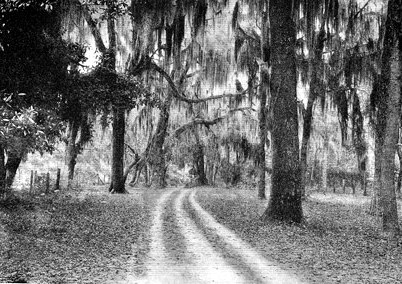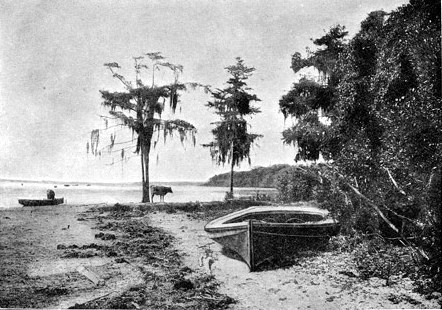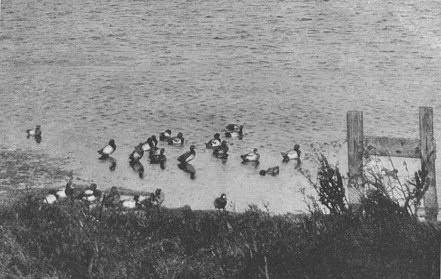|
(Return to Web Text-ures) |
Click Here to return to Florida Trails Content Page |
 (HOME) |
|
(Return to Web Text-ures) |
Click Here to return to Florida Trails Content Page |
 (HOME) |
|
FLORIDA
TRAILS
CHAPTER 1 GOING SOUTH WITH THE WARBLERS When I left New York, I thought that I had said good-by to the smaller migrating birds for three days. My steamer’s keel was to furrow nearly a thousand miles of rough sea before it landed me in Florida, where among live-oak and palmetto, bamboo and sugar cane, I might hope to meet tiny friends that I had loved and lost a while. I rather expected flocks of migrating sea birds, and in this I was disappointed. The usual gulls whirled and cackled in our wake, kittiwakes and herring gulls, brown backs and black backs, a horde that thinned with each steamer we met, taking return tickets to port, seemingly loath to leave the fascinating region of Coney Island. The hundreds had dwindled to almost a lone specimen before, just off Charleston: the pelicans came out to look us over. Not a duck did I see till the pelicans had approved us. Then we began to drive out scattered flocks. Perhaps the northwester that had chased us all the way had something to do with it. For it was almost a blizzard out of New York. Up in Central Park the English sparrow, like Keats’s St. Agnes’ Eve owl, for all his feathers was a-cold. The little children of the rich, parading the walks with bare knees, and nurse maids, were blue with the chill and might well envy the little children of the poor for whom the charitable provide stockings. Even out at sea the wind and cold seemed to chill the water till it was made of blue shivers and gooseflesh combers. Yet I had reckoned without my host, so far as the little migrants are concerned, for, waking the next morning some two hundred miles or more farther south and far out of sight of any land, the first sound that I heard was the tchip of a myrtle warbler. Verily, thought I, this is some trick of the vibrating rigging, quivering under the thrust of the screw. Then I looked up and saw the bird himself, sitting on the rail, whence he flew serenely to a passenger’s hat. Then I was quite convinced that it was high time that I had a change, found fresh woods and pastures new. Too steady a pursuit of a subject is apt to end in hallucination, as many a latter day theosophist ought to be able to testify. However, this specimen of Dendroica coronata was not materialized through concentrated thought, but was a real myrtle warbler, and there were a dozen, more or less, hopping about the ship. During the next thirty-six hours the number of bird passengers carried, summed up, would, I am sure, far exceed the paying passenger list. We identified pine warblers, robins, song sparrows, chipping sparrows, fox sparrows, Wilson’s warblers, juncos, golden-crowned kinglets, ruby-crowned kinglets, bay-winged buntings and a white-bellied swallow. With a few exceptions these seemed to be young birds, rather storm-buffeted and weary. Whether they lighted on the ship as a convenient resting-place in the regular course of their migration, or whether they had been blown off to sea by the strong westerly wind, it is impossible to say. I think the former. The wind was blustering but by no means a gale, and they could easily fly against it. They seemed most numerous at daybreak, and I think they were attracted by the ship’s lights during the night, and stopped on it to feed and rest at morning, as they do on land. Possibly, also, the younger generation of birds is finding that it is a good deal easier to go South by steam power than it is to get there by arm strength. Why not? In a century or so chimney swallows have learned to build in chimneys rather than in caves and hollow trees. Blue birds, martins and white-bellied swallows have learned the uses of bird boxes. Why shouldn’t they adopt steamships? The wireless operator who pulls all sorts of information out of the circumambient atmosphere tells me that they have; that at this season of the year the ships are apt to swarm with tiny songsters, and the young lady from up the State who sits at the piano in the social hall and coquettishly sings about “the saucy little bird on Nellie’s hat,” is now able to do it with illustrations. This lighting of the myrtle warbler on the passenger’s hat is not persiflage, either. Several times it happened. Along in the afternoon a negro, sitting in a sunny corner of the steerage deck, held nevertheless the very center of the stage for several minutes with a junco perched on the crown of a well-brushed black soft hat that might have been as old as he was. It made a rather pretty picture and the old man’s eyes shone with delight long after the junco had flown. “Ya-as,” he drawled to his companions after the bird had gone, “dem birds, dey al’ays does laike dat hat. One day down in Souf Ca’lina ah was sitting in de field a long time an’ one of dem cuckoo birds des came along and laid an aig in dat hat. Yessir, it done did.” This may be true. I tell it as I heard it. All these free passengers seemed far tamer on shipboard than on shore, and manifested it in other ways than lighting on people’s hats. They hopped chirping about the decks almost under foot, to the delight of the ship’s cat, which caught one and escaped the wrath to come by dodging to some hole below decks with it. They even invaded the dining-room and picked up crumbs from the carpet, and it was no uncommon thing for one to flutter from under foot as passengers came along the corridors. Now and then one would leave his comfortable perch, flit in a wide circle about the ship, and come back as if loath to leave so firm a foundation and such good fellowship. I missed the white-bellied swallow first. Surely his wings should take hint to land without serious effort. One by one the others departed, many remaining until the ship was off the Hatteras Shoals and the land not more than a dozen miles away. Even then it seemed as if the little warblers and tiny kinglets were taking long chances with the stiff wind and the foam-crested billows. In starting off they flitted down toward these as if they intended to light on them, swerving upward from the very imminent crest of many a wave and dipping into the long hollows again in flight that matched the undulations of the sea. I hope they all reached land. Probably in migrating time the sea takes toll of all flocks and thus helps nature in her ruthless weeding out of the weaklings. There were no small migrants remaining by the time the pelicans came out to inspect ship. I have great respect for the pelican, a respect which increases each time I see him, he is such a venerable gaffer of a bird. Even in the confines of his hen-fenced enclosure at the ostrich farm in Jacksonville, he does not lose this aspect of dignity. The group sitting and flitting about their tiny tank always reminds me of the delineations of the Hebrew prophets in the mural decorations of the Boston Public Library. They (the pelicans) have a faintly straw-colored top to the head which reminds one of a bald and massive dome of thought, and they draw their beaks back against their necks till they are for all the world like long beards. Then there is an intellectual solemnity about them that I am sure their character does not belie. Even when they play at leap-frog, clumsily flopping one over another in the pool, they do it in a way that convinces you that they have it all reasoned out and are not entering into it lightly or without due consideration. They are a clean bird in captivity and are so quaintly awkward in their movements that one loves them at sight. But the pelicans are best seen as they fly in an orderly line from somewhere shoreward, out to the ship inspection. Several flocks of ten or a dozen came alternately flapping and sailing, their wings all beating time with those of the leader as if in a careful drill movement. They sailed over the ship and then settled upon the water, still in an orderly row, and I thought I saw each flock confer after sitting and wag bald heads and long beards as if in approval. As we steamed up the St. Johns we left them there, for the pelican fishes only at sea and disdains the brackish water of the river which flows miles wide from the interior of Florida. As a first glimpse of Florida bird life they are satisfying and of unusual interest. I recommend them to any who may sail in my wake.
The cormorants came next.
The viking bird of which Longfellow jingled,
may have been all that the poet’s fancy painted him, but the Florida cormorant certainly does not fill up to the measure of the poem. Fierce he may be to little fishes, but to the eye of the passer up the river his chief characteristic is purely dolce far niente. Hardly a river buoy or sandbar marker post but has a cormorant, looking as much like a black carving at the top of a totem pole as anything else. Usually he is as motionless. He stretches his slim, snake-like neck as the boat goes by, sometimes even moves it uneasily, but his body keeps up the statuesque pose to perfection. No doubt the cormorant dives and swims, flies and fishes, but so far I have found him only as the topmost carving on the buoys and marker posts. This Florida variety is slightly smaller and otherwise different from the birds of the Northern coast. Chapman describes him as a shy bird. A cursory glance would seem to indicate that the only thing he is shy of is energy. The first Florida land bird that I saw was the buzzard. If the cormorant is the statue of repose, the buzzard is the poet of motion. I suspect that this bird was the original mental scientist. He moves by thought-power alone. I am always reminded, in watching his progress, of the ancient story of the Chinaman watching his first electric car. The buzzard certainly has no visible “pushee” or any observable “pullee.” But how silently and beautifully he goes. Never a flap of the broad black wings and never a quiver of the widespread primary tips. He just thinks himself along, against the wind or with it, up or down. His broad wings are like the prayer rug of the Arabian tale. He adjusts himself upon them, stretches forth his bald red neck and just wishes himself in some place, near or far, and forthwith he sails swiftly to it. In what as yet unexplained principle of progress he finds his power no present-day aeroplanist can say. When he finds out, the flying man of the future may do away with the motor which so frequently fails to mote and the propellers which break in mid-air and spill the passenger. Go to the buzzard, thou Bleriot; consider his ways and be wise.
The little river steamer
that takes you up the St. Johns from Jacksonville to Orange Park soon
leaves the uproar of the city, the skyscrapers and drawbridges, tugs,
lighters, and coastwise steamships behind, and puffs onward into placid
reaches that to the eye have changed little since the days of De Soto.
If plantations and villages exist ashore there is but little indication
of them. The banks are lined with verdure, green and gray-green with
the foliage of century-old live-oaks and tall, long-leaved pines, gray
with exquisite festoons and dangling draperies of the moss that
decorates every tree and fairly smothers some of them. There is a
crinkly grace, an elderly virility about it that is most engaging. It
takes but little effort of the imagination to see the red cheeks and
twinkling eyes of a myriad disciples of Santa Claus peering through it
ready to bring gifts to good children. I have yet to see with what
costume they simulate the good saint in this country. If they do not
make his beard of this softly beautiful, crinkly, fatherly gray moss I
shall feel that they miss an excellent opportunity. Here and there
through the moss and among the big, rough tree-trunks a tiny road winds
down through the needle-carpeted sand and leads to a slender long pier,
built far out over the shallow reaches of the river to a landing for
the river boats. The stream is miles wide in its lower course, but only
in its channel is it deep. Shallows stretch far from either bank and
fleets of water hyacinths voyaging seaward with the current strand
sometimes far from shore. The fifteen-mile trip is thus like one into a
sub-tropical wilderness untouched by the chill of approaching winter,
little marred by the hand of man. The miracles of gorgeous autumn
coloring which we left behind in the Massachusetts woods find no echo
here. Now and then a sumac leaf shows dull crimson or the wild grape
takes on a somber yellow, yet these tiny dots of color are no more to
be noticed in a general survey of the forest than the bright hues of
the butterflies that swarm at midday in the bright sun and a
temperature of eighty in the shade.  "Profuse draperies of moss pendant from each branch and twig"  "To march along this water is to promenade a river side and a sea beach in one"  "Lesser scaup ducks are very tame in Florida waters all winter" It is a new land, yet it has beauties that are all its own. The full moon was rising over the eastern shore of the river as I climbed its west bank, lighting up the broad central street of the little town with golden radiance. Here for a moment with the soft sand underfoot and the stately live-oaks arching overhead I might have thought myself in a Cape Cod village. The neat white fences were the same, the sand was the same with sparse grass growing from sidewalk to wheel tracks, and the live-oaks that arched till their limb tips touched and made play of soft shadows and softer light underfoot might well have been the Massachusetts elms. Only the profuse draperies of the moss pendant from every branch and twig were new, informing the place with a golden glamour of grace and mystery. “Isn’t it wonderful! “ exclaimed the lady from Boston. “Ye-es,” replied the lady from Philadelphia, doubtfully, “I think it’s nice; all but that ragged moss all over everything. It reminds me of untidy housekeeping.” Thus points of view differ. It was perfectly conventional and exactly proper that the first bird I heard singing here the next morning should be the mocking bird! It is little wonder either, for these beautiful songsters infest the place, as numerous and familiar as robins on a Northern lawn. I have an idea that the mocking bird is just a catbird gone to heaven. He seems a little slenderer and more graceful. His tail is a bit longer and the catbird’s earthly color of slate pencil has become a paler, lovelier gray in which the white of celestial robes is fast growing. Already it has touched his wing bars, and his tail feathers, and all his under parts. So a bit of celestial beauty has been added to his song, which is rounder and more golden, yet holds much of the catbird’s phrasing still. People may say what they will about the catbird at home. With all his faults I love him still, and it pleases me to fancy that he becomes a mocking bird as he becomes good and noble.
After the mocking bird’s
whistle came a second melodious note, the tinkle of passing cow-bells,
recalling to mind once more quiet elm-shaded New England streets and
rock-walled pasture lanes. Yet in this tinkle was a puzzling note as
the cattle passed and the sound faded into the distance, a bubbling
change of tone, a liquid drowning altogether new and delightful. I
followed its siren call to find myself led, as by the sirens of old, to
water. Down the streets of a morning wander the scrub cows of the
place, munching live-oak acorns as they pass to their grazing grounds,
the shallow waters of the St. Johns. Into this they wade fearlessly,
often neck deep and a quarter-mile from the shore, sinking their heads
to the bottom to feed on the tender herbage of aquatic plants. The
tinkle of the cow-bells catches its bubbling note and its drowning fall
in its continual submergence and resurgence. It is as characteristic of
a St. Johns River town as the melody of the mocker, different, but
perhaps equally delightful in its musical quaintness. |